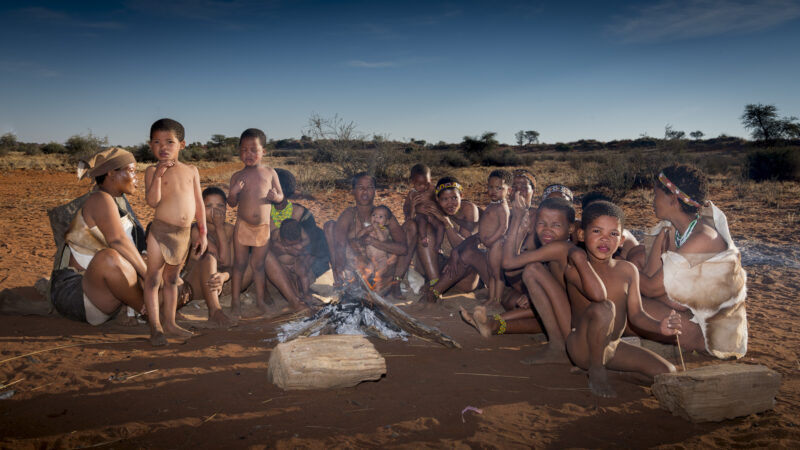Road trip through Namibia: the Kalahari Desert
A road trip through Namibia takes us to the deep red, sandy savannah of the Kalahari. We spot African wildlife, meet members of the San tribe and stay at a charming game ranch.
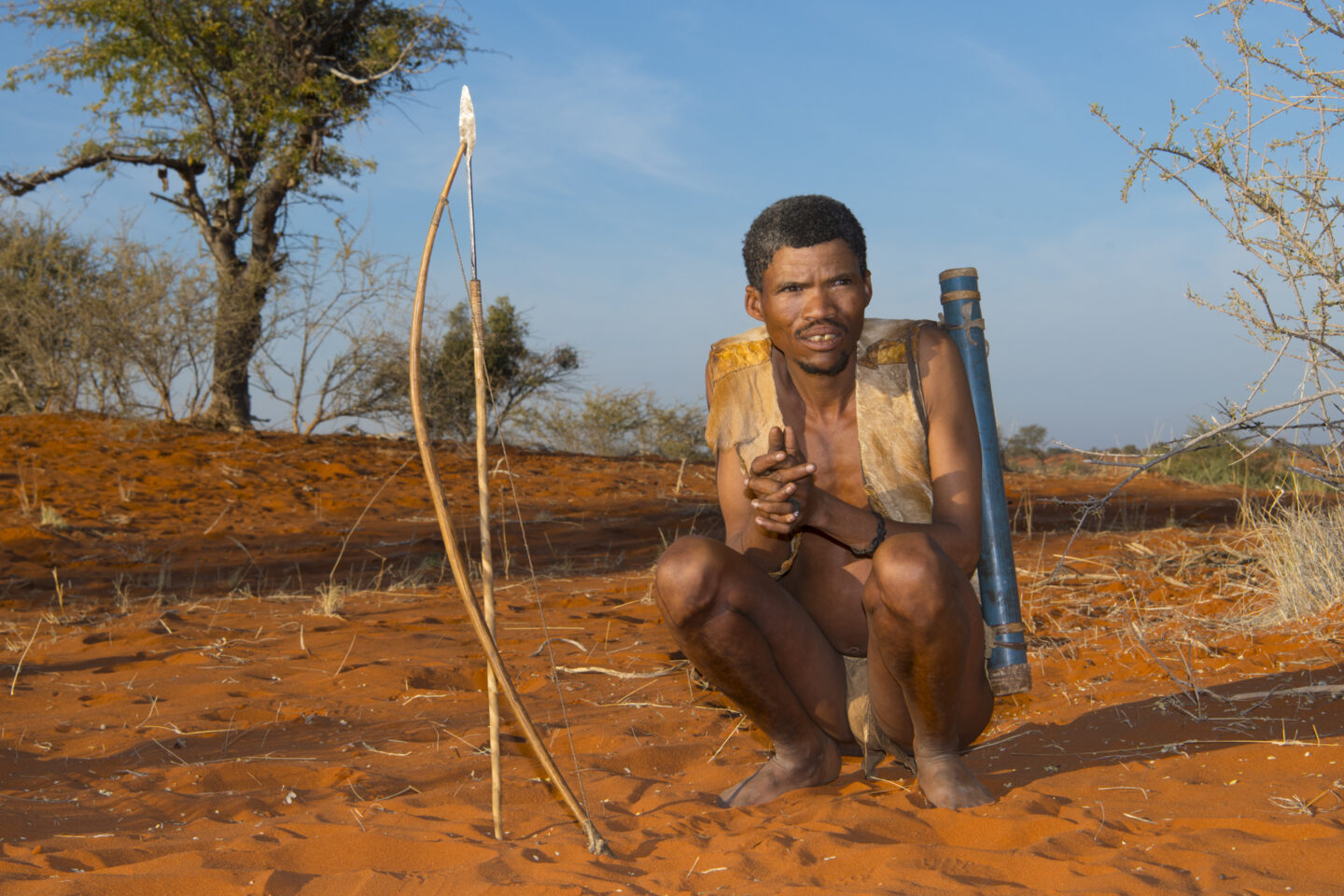
The Kalahari, a vast semi-desert
The Kalahari is a vast semi-desert area that stretches across large parts of Botswana, South Africa and Namibia with foothills into Zimbabwe and Angola. The Kalahari's landscape is unique. Parallel lines of red dunes, visible to the naked eye from space, alternate with grassy savannah. The acacia tree is ubiquitous and vital to the indigenous San, or Bushmen. It is dry, very dry. Water from the rare rains collects in the areas between the dunes. This is where most of the vegetation is found. The trees that grow there sometimes have roots that reach up to 40 meters deep. The fauna of the Kalahari is very diverse. Lions, leopards, numerous species of antelope, giraffes, ostriches and other birds have adapted to the harsh life in this area. We will be introduced to all these aspects of the Kalahari during our stay in Namibia.
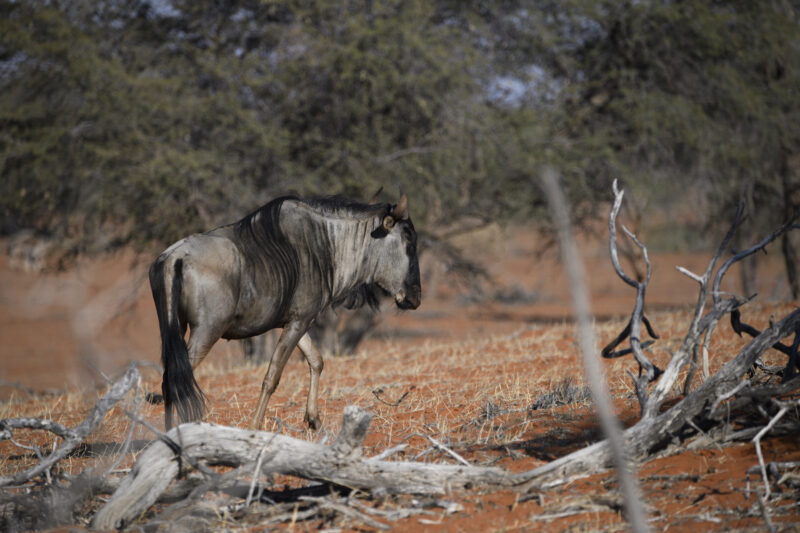
Bagatelle Kalahari Game Ranch
A 3-hour drive through a wild and desolate landscape brings us to Bagatelle Kalahari Game Ranch. Situated in the middle of a nature reserve on the edge of the Kalahari, this charming lodge offers a tranquil stay in the style of a South African farmhouse. The bungalows, each with breathtaking views, are scattered throughout the pristine Kalahari wilderness. A variety of antelope species live here, as well as wildebeest, zebra, giraffe and ostrich. The ranch is also a sanctuary for sick and injured animals. They are taken in, cared for and then released back into the wild. Some recovering animals roam freely on the ranch. For example, during our lunch on the patio we were introduced to an elk antelope and an ostrich. Daily, the ranch offers a long list of activities to explore the Kalahari. We signed up for some game drives and the Bushmen walk.
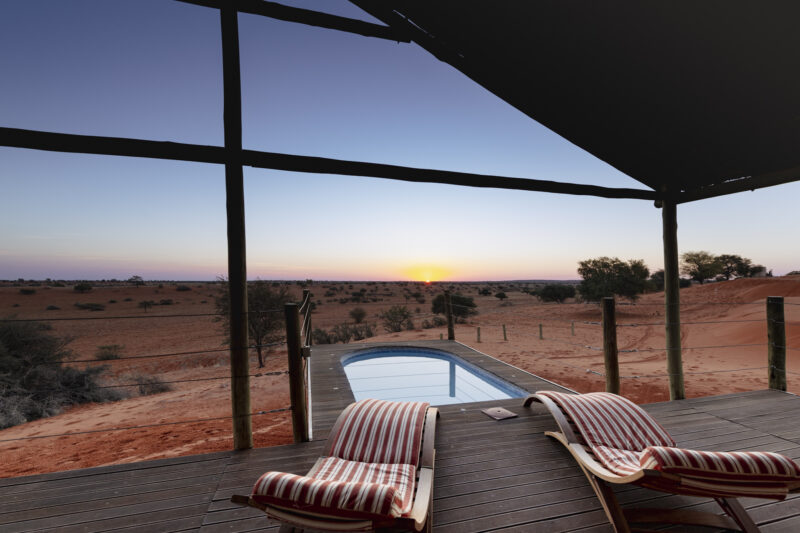
An exciting game drive through the Kalahari
It is 7 a.m. and we set off in an open jeep for an exciting game drive through the Kalahari. The sun is slowly rising, transforming the sky into a palette of pinks, blues and oranges. Oryx, Namibia's national animal, are everywhere, as are zebra and springbok. We arrive at a vast salt flat where we find other antelope such as black impala and blesbok.
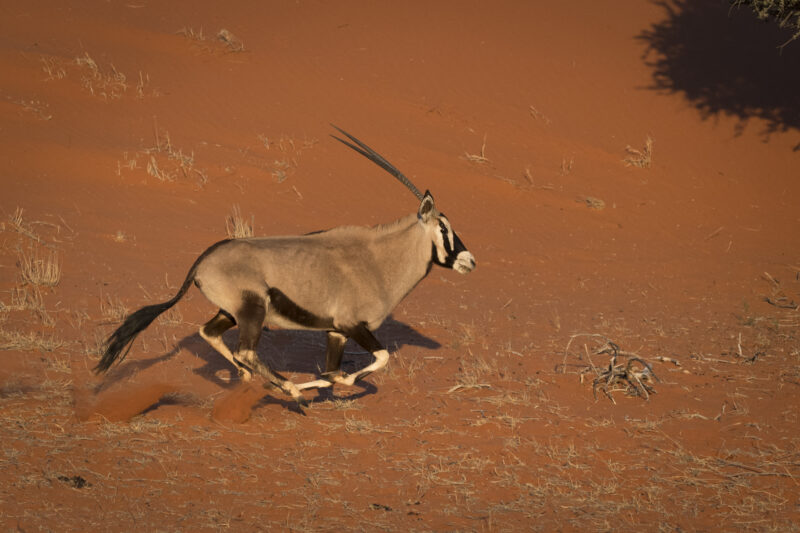
We reach a series of dunes and among the dry vegetation we see not only springbok but also kudu, an antelope with large floppy ears, spiral horns and fine pale stripes on its rump. We also learn to identify the woolly waterbuck and the red-brown hartebeest. The goal of the drive through the red sand hills is the giraffe. After a while we come across a herd of 15 giraffes. These graceful animals move with surprising speed for their size. They are sometimes difficult to spot between the acacia trees because of their slenderness. The giraffe is not as shy as the zebra and we get a chance to observe the group up close. A baby of barely 3 months stays close to its mother and the dominant male oversees the herd. Overwhelmed by the magnificent spectacle, we head back to the ranch for a hearty breakfast.
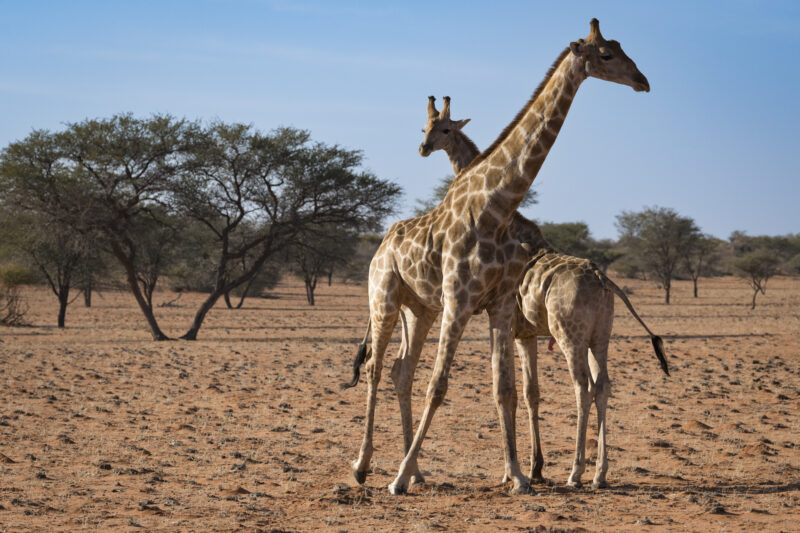
Excursion with the cheetahs
At dusk we set out on a cheetah excursion. I look forward to this rare opportunity to see the animals up close.
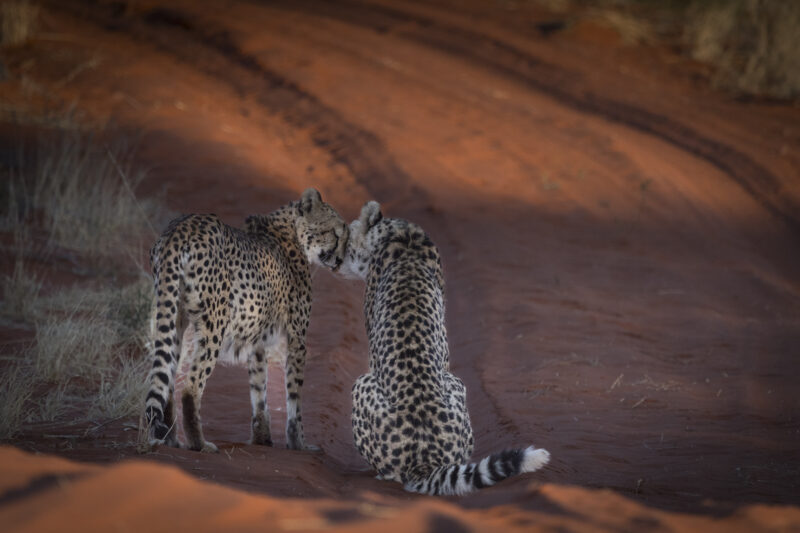
The conflict between farmer and predator
Namibia has been struggling for years with conflicts between farmers and predators. It is usually female cheetahs that attack goats and cows to feed their young. The mothers are often killed in the hunt and the cubs starve to death. Today, thanks to an unwritten agreement, farmers report the problem to the local government. The remaining cubs or the problem animal itself are rounded up and taken to a sanctuary.
The Bagatelle Kalahari Game Ranch, in partnership with the Cheetah Conservation Fund, captures 7 cheetahs in a free but fenced 12-hectare area. The animals are habituated and can be approached and fed by humans. The goal of the project is to raise awareness of the problem and to protect the animals from indiscriminate killing.

The unique experience of feeding a cheetah
We drive through a high fence into the protected cheetah area. Two cheetahs approach quickly. They recognize our guide Ziggy from a distance. He gets out of the vehicle to the chirping of the cheetahs and immediately takes control of the animals. We get out, but under no circumstances are we allowed to bend down or be on the same level as the cheetahs. Ziggy pulls out a bowl of meat and the animals immediately forget our presence. One by one we approach the cheetahs and touch them. It is a unique experience. The fastest predator in the world, capable of running up to 120 km per hour, stands next to us like a purring cat as we stroke its head. Everything happens quickly because once the food is consumed, the cheetah simply goes on its way.
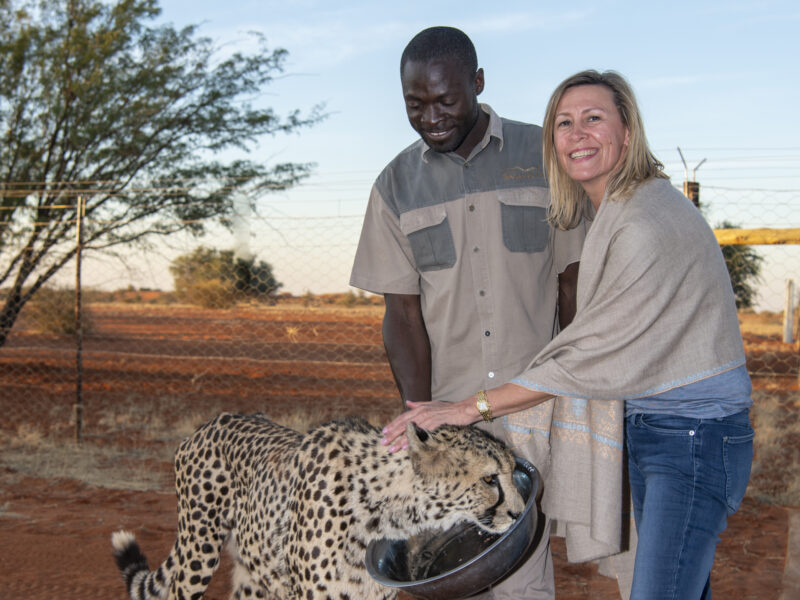
Time for a sundowner
We say goodbye to the fascinating cheetahs and Ziggy takes us to a high sand hill. It's time for a sundowner with breathtaking views of the vast Kalahari. We enjoy the panorama as the blue sky changes in an instant to a spectacular display of oranges and pinks, culminating in a deep red. A sunset in Africa is indeed a special experience. It is getting dark and the temperature is dropping rapidly. The reds gradually give way to the splendor of the Milky Way and other galaxies. There is no end to the wonders of this beautiful land.
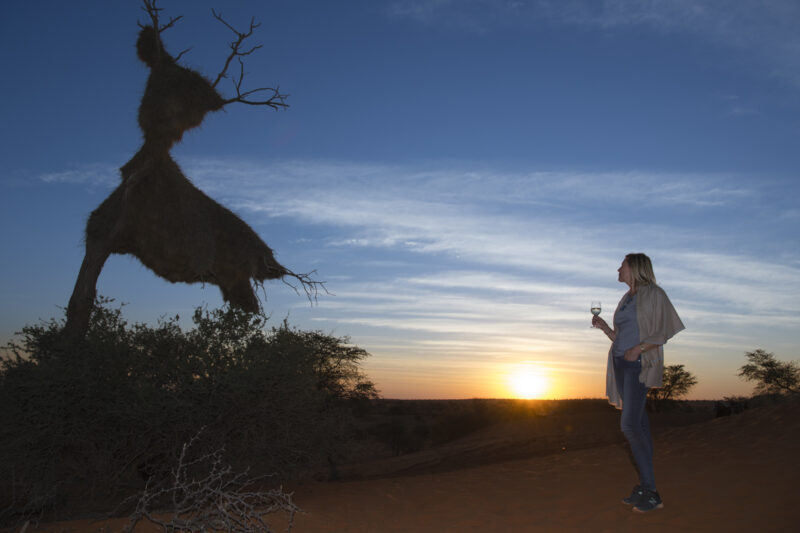
Learning from the Bushmen of the Kalahari
Once again, we rise early to meet and hike in the Kalahari with members of the Bushman tribe. The San are the oldest inhabitants of southern Africa and their tribes are scattered across Namibia, Botswana and South Africa. They are known as a nomadic people who follow the rain, taking only what they can carry. Our guide Gabriel is a member of the tribe himself and translates their tips for survival in the Kalahari from the typical click language into English.
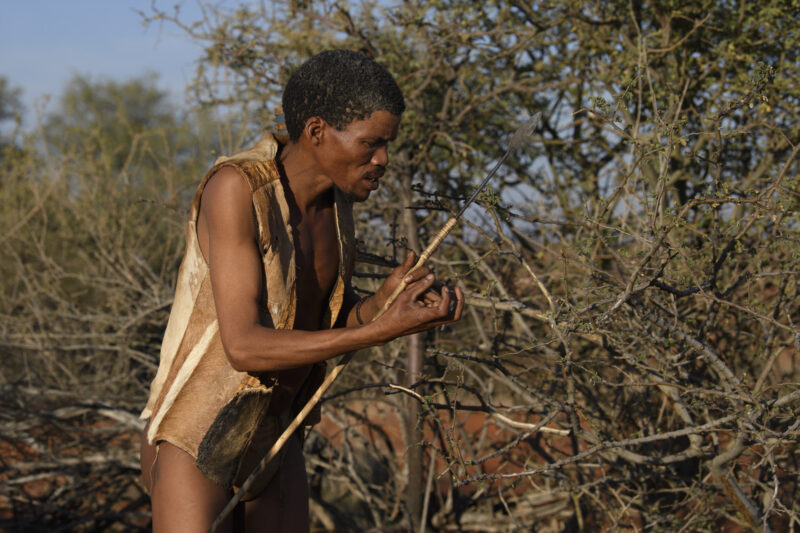
A humanitarian project
The Bagatelle Kalahari Game Ranch is running a humanitarian project to show the outside world how the Bushmen live. A number of San families have come from northeastern Namibia. About 20% of the 2,500-member tribe still live in the traditional way. Part of the proceeds from the project go back to the tribe to fund education, health and local infrastructure. Families rotate every six months. After a protest by a journalist, the program was temporarily suspended, and the village was closed. Three years later, the government determined that the tribe's living conditions were deteriorating without the support of the Bagatelle project. The ranch was allowed to resume the project, and the families returned to share their culture with visitors.

Kalahari termites
Two San men explain in their click language and with gestures how they use termites to survive. A termite mound consists of a highly organized colony that lives up to 100 years. Some mounds are more than 2 meters high. The queen resembles a giant caterpillar that can lay 30,000 eggs a day. The soldiers of the nest have strong jaws and are used to suture wounds. The termites are placed on the wound and bite spontaneously. The body is twisted off, leaving the head with the jaws attached. The wound is sutured. There are also termites with wings. They fly off and form new colonies. Winged termites are 4 to 5 cm long and are a nutritious delicacy. Termites also attract aardvarks, an important part of the Bushmen's diet. The meat is cooked in a fire pit in the ground and the skin is used as a bowl. The aardvark's fat provides protection from mosquitoes, the sun and the cold.
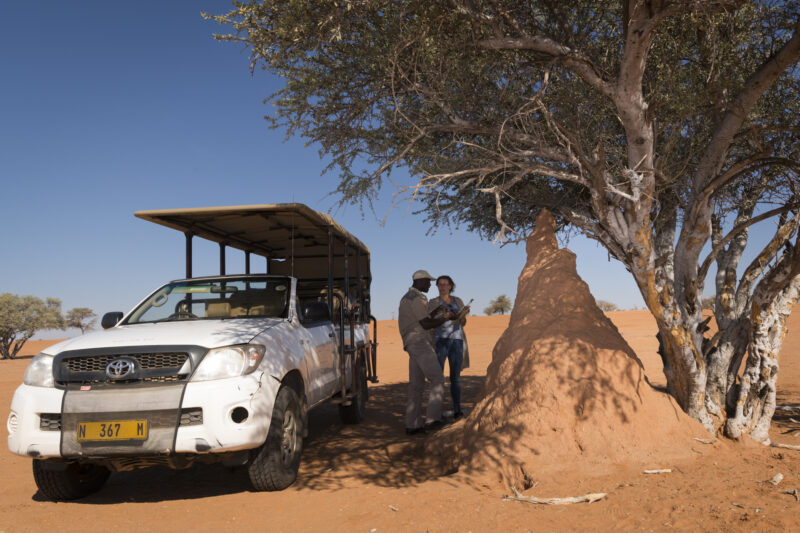
The acacia tree
The Bushmen speak of the acacia tree with great respect. The bark of the acacia tree is an important medicine. The San remove the thorns and chew the bitter bark to treat sore throats and coughs. Sometimes they boil the bark in water until they get a yellow liquid. This is then used as cough syrup. The fruit of the acacia tree grows in winter and plays an important role in hunting. The fruit contains a hunger suppressant and helps the Bushmen control their hunger until they catch their prey.
The ostrich of the Kalahari
We walk further into the Kalahari and find a number of ostrich eggs scattered on the ground. Most of the eggs contain no life and have been there for a long time. Ostriches lay up to 100 eggs per year. The dominant pair builds a main nest and the other ostriches lay their eggs near the nest on the ground. Fewer than 60% of the eggs hatch.
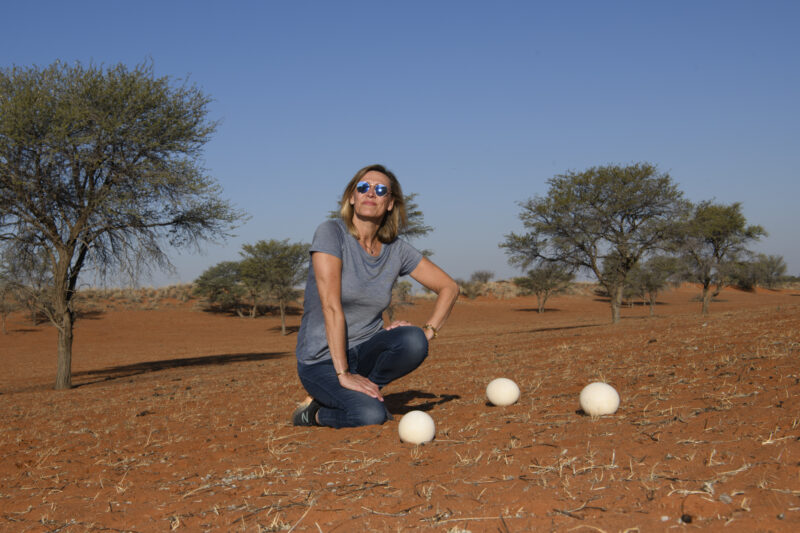
Ostrich eggs play an important role in the Kalahari's human and animal food chain. Our guide explains how the Bushmen approach a nest with 3 people. Two of them lure the ostrich from the nest, while the third takes only the unfertilized eggs. The hunters use an arrow to pierce a hole in the top of the egg and pour out the yolk and white onto a layer of glowing charcoal. This is how they cook an omelet. The shell is not discarded. The Bushmen fill the empty egg with water and plug the hole with grass. They hide the water-filled egg in the bush under the sand. This is the water reserve for a future hunt. Sometimes the hunters make eating bowls out of the egg. They drill holes around the egg with an arrowhead and break it into two equal halves. The women make ornaments from the shells. Sometimes the eggshells are ground into powder. The powder, mixed with aardvark fat, is a medicine for small children against colds.
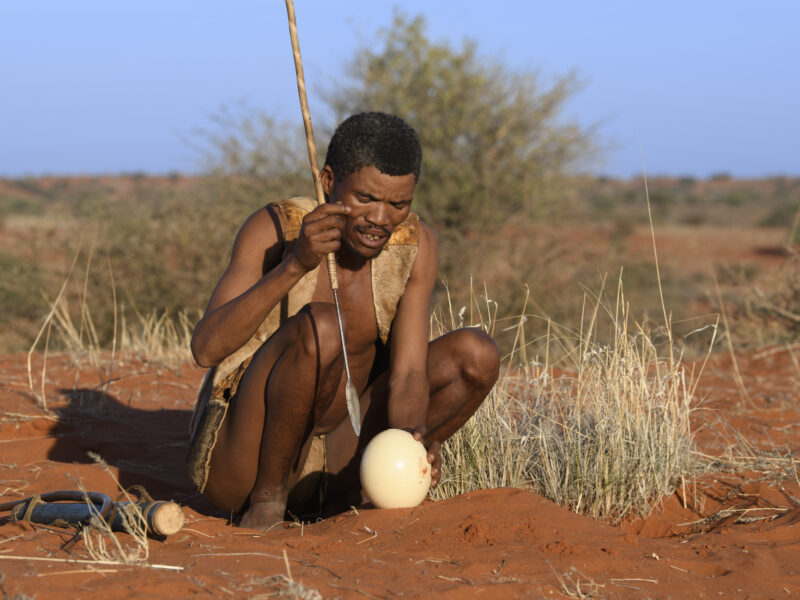
The San village
After these fascinating revelations, we move on and approach a replica San village. The women and children are sitting around a wood fire. They talk and laugh, and the children run and play. Around the huts hang traditional jewelry made of eggshells, dried berries and pieces of wood. I am immediately tempted and buy some necklaces and a bracelet. The women smile at me with gratitude. Happy to have supported the tribe and touched by the experience, I return to the ranch.
